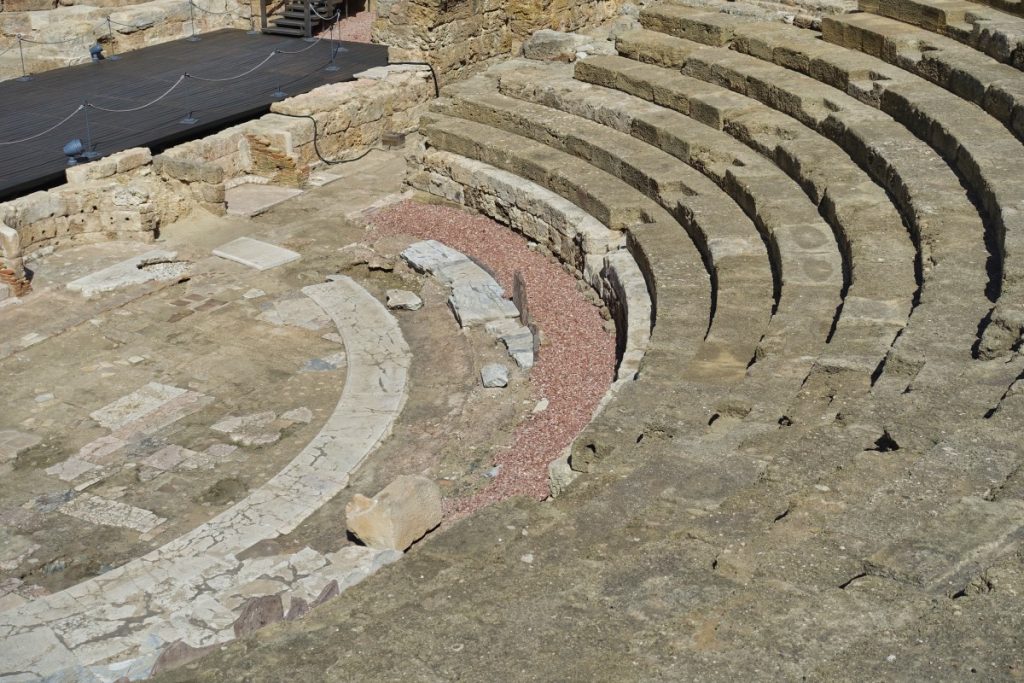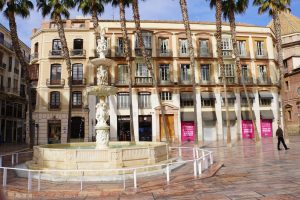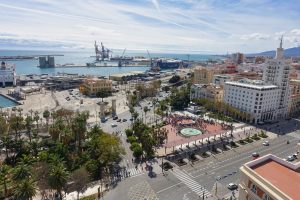A tour of Malaga’s old town also takes you to the hill where the Alcazaba is located. Here, at the foot of the hill, is the Roman Theatre of Málaga, a building that you would not expect to find in the city.

Why is there a Roman theatre in Málaga?
The Roman Theatre is one of the most important testimonies to the Roman presence in the city. The Romans built it at the beginning of the Empire at the beginning of the 1st century AD, during the reign of Emperor Augustus. By remodelling the city, they wanted to consolidate an adaptation to the new politics and the economic and religious changes among the citizens.
The people of Málaga used the theatre for over two centuries. Today it is assumed that it was abandoned in the 3rd century AD and slowly fell into disrepair.
Later, the salt industry used the site. During excavations, which can be seen for example under the glass pyramid in front of the theatre, basins were found in which salted fish was produced.

Around the 5th century AD, the use of the site changed. Today, based on findings, it is assumed that the area of the Roman theatre was used as a cemetery (necropolis). Some graves have been found on the higher level of the theatre.
When the Arabs ruled Malaga, they used the remains of the theatre to obtain building materials for the Alcazaba. Some of the elements of the Roman theatre were found in the construction of the Alcazaba, such as columns and capitals as supports for the portals.

Many years followed in which nothing was known about the existence of the Roman Theatre. The area was built on and it was only when construction work began on the Casa de la Cultura and in 1951, while landscaping the open spaces in front of the main entrance, that people began to look a little more closely. A construction was found that was thought to be a gate in a Roman wall. Further excavation revealed a series of staggered tiers that directly adjoined the arch. It soon became clear that this must have been a Roman theatre.
Several years of archaeological work followed and even the House of Culture was demolished to expose the entire site. Today, the Roman Theatre of Málaga is open to the public and one of the city’s tourist highlights.

Visit to the Roman Theatre Málaga
A visit to this interesting building is free of charge. You can enter the remains of the complex through a small exhibition building and walk along some paths. Another entrance can be found above the theatre, directly next to the entrance to the Alcazaba. From there, you can access the theatre’s spectator gallery and enjoy the elevated view of the excavation site.

If you only want to take a quick look, you can also see the grounds very well from the road. A viewing platform has been specially built. Or you can walk up a few steps behind the visitor centre. There is a good vantage point there.

When you enter the excavation site, you are in an area that was used as a bath before the Roman phase in the city. Parts of the floor have been preserved despite the conversion into a theatre and are still visible today.
The theatre itself, with its 31-metre radius, 16-metre height and 15-metre orchestra, is one of the medium-sized installations. It is divided into three sections:

The so-called orchestra, a semicircular space between the seating circle and the stage, was decorated with large marble slabs. This was the place for the members of the high offices and the choir.

The cavea is the auditorium in the Roman Theatre of Málaga, directly adjacent to the orchestra. Parts of the rows of seats for the audience are still preserved today. They are partly built into the mountain and the view of the audience was towards the city.
The stage (proscenium ) is a semicircle. This shape provided all spectators with an optimal view and good acoustics. At that time, the theatre space was spatially separated from the city by creating a façade with columns and sculptures.
Since 2011, the Malaga Roman Theatre has been used for performances in the summer.

Address:
C/ Alcazabilla, s/n,
29015 Málaga, Spanien
Opening hours:
Tuesday – Saturday: 10.00 a.m. – 6.00 p.m.
Sunday: 10.00 a.m. – 4.00 p.m.
Closed:
Monday, 1 and 6 January, 1 May, 24, 25 and 31 December.
Admission fee:
free










Leave a Reply